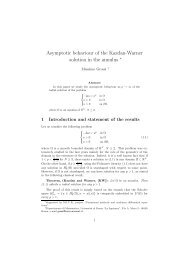Singular metrics and associated conformal groups underlying ...
Singular metrics and associated conformal groups underlying ...
Singular metrics and associated conformal groups underlying ...
You also want an ePaper? Increase the reach of your titles
YUMPU automatically turns print PDFs into web optimized ePapers that Google loves.
2 K. R. Payne<br />
L = K(y)∆x + ∂ 2 y<br />
(1.1)<br />
where (x, y) ∈ R N × R, ∆x is the Laplace operator on R N with N ≥ 1, <strong>and</strong><br />
the coefficient K ∈ C 0 (R) satisfies<br />
K(0) = 0 <strong>and</strong> K(y) = 0 for y = 0. (1.2)<br />
The equation degenerates along the hypersurface y = 0 <strong>and</strong> our main interest<br />
will be cases in which K yields a change of type; that is, K also satisfies<br />
yK(y) > 0 for y = 0 (1.3)<br />
so that the operator (1.1) is of mixed type (elliptic for y > 0 <strong>and</strong> hyperbolic<br />
for y < 0). However, much of what will be discussed depends only on the<br />
form of the degeneracy in (1.1) − (1.2).<br />
In the paper [15], we classified the symmetry <strong>groups</strong> <strong>and</strong> calculated the<br />
<strong>associated</strong> conservation laws for the equation Lu = 0, which is the Euler-<br />
Lagrange equation for the Lagrangian<br />
L(y, u, ∇u) = 1 <br />
K(y)|∇xu|<br />
2<br />
2 + u 2 y . (1.4)<br />
In fact, the class defined by (1.1) − (1.3) represents the simplest examples<br />
of second order equations of mixed type <strong>associated</strong> to a Lagrangian with<br />
degeneracy on a hypersurface. As is to be expected, the largest possible<br />
symmetry <strong>groups</strong> occur when K takes a pure power form<br />
K(y) = y|y| m−1 , m > 0 (1.5)<br />
in the mixed type case, or ±|y| m in the purely elliptic/hyperbolic but degenerate<br />
cases. The operator in (1.1) with (1.5) is known as the Gellerstedt<br />
operator <strong>and</strong> gives the Tricomi operator when K(y) = y, while the choice<br />
K(y) = y 2 yields the degenerate elliptic Grushin operator. Such operators<br />
arise in many physical <strong>and</strong> geometrical problems with a particular structure,<br />
such as: transonic fluid flow [3] [16], quantum cosmology [11], <strong>and</strong> the imbedding<br />
of manifolds with curvature that changes sign [13]. See also section 6 of<br />
[15] for a brief discussion.<br />
If one takes the limiting case, m = 0 in (1.5), one arrives at the Laurentiev-<br />
Bitsadze operator which glues the Laplacian for y > 0 to the D’Alembertian<br />
for y < 0. It is well known that the symmetry <strong>groups</strong> for these classical<br />
operators are given by the group of <strong>conformal</strong> transformations with respect<br />
to the Euclidian <strong>and</strong> Minkowski <strong>metrics</strong> respectively (cf. [17] <strong>and</strong> [5]). We will<br />
show that this also holds in a suitably interpreted sense for the mixed type<br />
operators satisfying (1.1) <strong>and</strong> (1.5) with respect to a suitable singular metric<br />
of mixed Riemannian-Lorentzian signature as announced in [15]. Moreover,<br />
the analogous result holds in the purely elliptic/hyperbolic but degenerate<br />
setting of (1.1) with K(y) = ±|y| m , m > 0.








